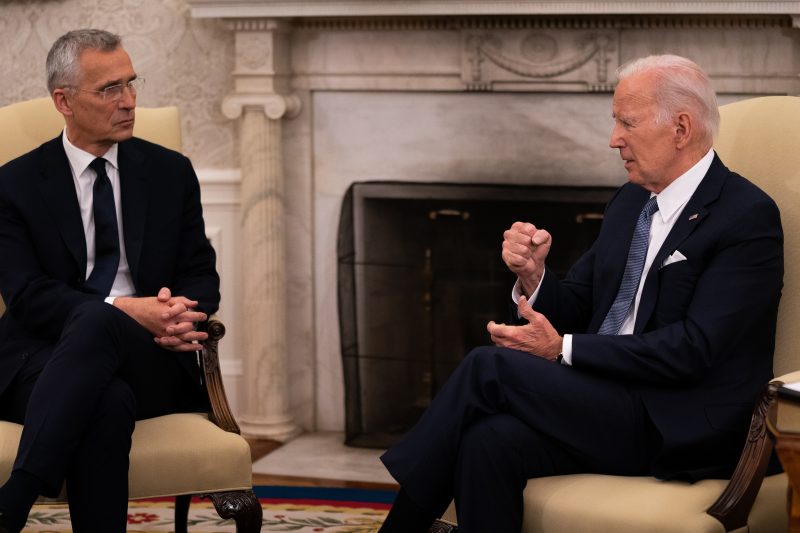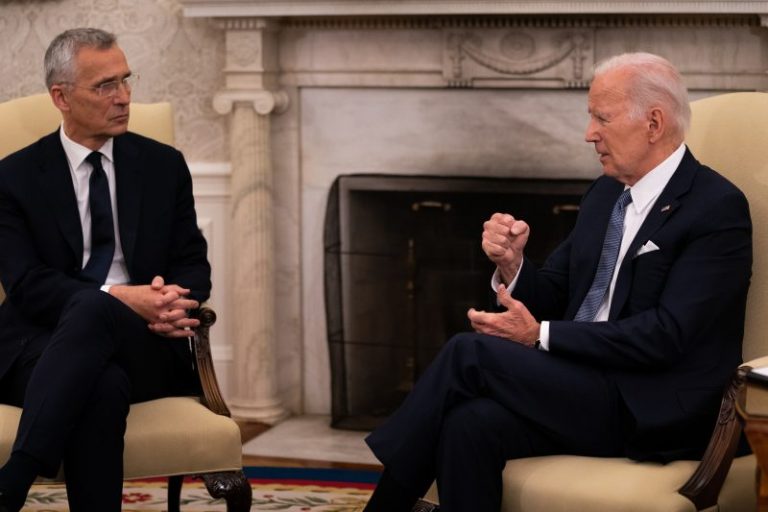
President Biden met with NATO secretary general Jens Stoltenberg on Tuesday afternoon as a host of challenges confront the allied group, reiterating America’s commitment to protect NATO countries that neighbor Russia at a time when Moscow’s aggression is on stark display in Ukraine.
The meeting, held in the Oval Office, paved the way for a NATO summit in Lithuania next month where the alliance’s 31 member states will face a range of thorny issues. Consensus remains elusive on questions including what security guarantees to offer Ukraine, whether Sweden should be granted membership and who will lead NATO when Stoltenberg steps down later this year.
At the start of Tuesday’s meeting, Biden stressed the United States’ commitment to defending any NATO country if any part of it comes under attack, a sentiment increasingly important to the eastern allies from Poland to the Baltics.
“We’ve strengthened NATO’s eastern flank, made it clear we’ll defend every inch of NATO territory,” Biden said. “At our summit in Lithuania next month, we’re going to be building on that momentum.”
Stoltenberg thanked the United States for a new package of military aid to Ukraine announced earlier in the day and said Ukraine’s current counteroffensive, aimed at expelling Russian forces from its territory, is “making progress.”
He added: “The more land the Ukrainians are able to liberate, the stronger hand they will have at the negotiating table.”
The meeting took place as a number of issues threaten the cohesion of the alliance, making the next month critical for building consensus ahead of the July 11-12 summit in the Lithuanian capital of Vilnius.
“This is going to be the most challenging [summit] in recent history,” said Douglas Lute, a retired U.S. Army lieutenant general who served as U.S. ambassador to NATO from 2013 through 2017. “You’ve got everything from war to leadership succession here. This will be a summit worth watching.”
Ukraine’s potential NATO membership is one of the major flash points, since Kyiv urgently wants to become part of the alliance but most diplomats believe it currently lacks the necessary political, social and military stability.
Most of NATO’s members support 15-year-old language saying that Ukraine will eventually become a member. But Ukrainian President Volodymyr Zelensky has been asking for a formal invitation to initiate the process, a move certain to be seen as highly provocative by Russia.
“That [issue] is the one that is likely to be most debated between now and Vilnius, because there are differences in the alliance,” said Ivo Daalder, a former U.S. ambassador to NATO who is currently president of the Chicago Council on Global Affairs.
Some countries, largely those in Eastern Europe, would like NATO to issue the formal invitation as a sign of welcoming Ukraine even if the country is unable to join for some time. Others, though, worry about drawing Europe more directly into military confrontation with Moscow and favor a more modest commit to recurring economic and military assistance to Ukraine.
“They aren’t willing to consider membership until after the war is over,” said Daalder, who served from 2009 to 2013. “As long as Ukraine is in a state of war, membership becomes almost automatically joining that state of war. And some members are not willing to do that.”
To date, Biden has been firm about maintaining the status quo, reiterating that Ukraine will become part of the alliance eventually but declining to make any formal moves in that direction for the time being.
“We’re not taking a position one way or another,” John Kirby, a spokesman for the National Security Council, said ahead of the Biden-Stoltenberg meeting. “I think you know that at Bucharest there was a declaration that made very clear that NATO should be in Ukraine’s future at some point in the future. Nothing has changed about that.”
At a 2008 NATO summit in Bucharest, Romania, the member states declared that Ukraine, as well as the nearby country of Georgia, “will become members of NATO.”
Meanwhile, Secretary of State Antony Blinken said Tuesday he expects NATO will commit to a “robust package” of political and practical support for Ukraine at next month’s summit.
Blinken made the remarks ahead of his meeting at the State Department with Stoltenberg, who praised the United States for its support for Ukraine while insisting that “European allies are also doing their part” by providing tens of billions of dollars.
The race to replace Stoltenberg has heated up in recent weeks as the end of his term approaches in October. While the process for selecting the NATO chief job is based on informal consultations among all member states, the views of the United States, which possesses by far the alliance’s biggest military, hold particular weight.
Diplomats from NATO nations have said that officials including Danish Prime Minister Mette Frederiksen, British Defense Secretary Ben Wallace, Dutch Prime Minister Mark Rutte and Spanish Prime Minister Pedro Sánchez are among the contenders.
For Britain, holding the NATO secretary general position would be a way to keep a high profile in the transatlantic alliance following its withdrawal from the European Union, a move that significantly diminished its influence.
“I know some people have wondered what kind of partner Britain would be after we left the E.U. I’d say, judge us by our actions,” British Prime Minister Rishi Sunak said when he visited the White House last week. “We’re committed to our values as ever, as reliable an ally as ever.”
He also noted pointedly that “the U.K. is proud to be, behind the U.S., the biggest contributor to the military effort in Ukraine.”
But many NATO watchers believe that Wallace is an unlikely choice, as smaller nations and those on Europe’s eastern flank press for the role. Asked during Sunak’s visit whether it was time to have a British secretary general, Biden demurred.
“Maybe — that remains to be seen,” he said. “We’re going to have to get a consensus within NATO to see that happen. They have a candidate who’s a very qualified individual. But we’re going to have a lot of discussion, not between us, but in NATO, to determine what the outcome of that will be.”
Meanwhile, momentum has gathered behind the candidacy of Frederiksen, who also visited the White House recently and whom Stoltenberg has described as “one of the most competent prime ministers in Europe.”
Frederiksen checks several boxes, including the possibility of becoming NATO’s first female leader. But Scandinavian countries have held the office for more than a decade, and newer members along NATO’s eastern flank are demanding consideration.
Frederiksen’s candidacy could be complicated by the fact that Denmark falls short of a NATO agreement that each member should spend at least 2 percent of its gross domestic product on defense.
The Danish government committed last year to hitting that benchmark by the end of 2030, and earlier this year, it allocated an additional $5.65 billion to upgrade its armed forces.
Sunak made a point of noting during his White House visit that Britain already meets the 2 percent threshold.
Another option would be for Stoltenberg to stay on for another year. The former Norwegian prime minister, who took the job in 2014, has already seen his tenure extended three times due to the war on Ukraine, and he has signaled he is not interested in another extension.
Kirby, when asked whether Biden plans to ask Stoltenberg to stay on, said, “I’m not going to get ahead of the president’s decision-making.”
“We’re grateful for Secretary General Stoltenberg’s leadership,” Kirby said. “Now, he’s gotten extended three times, and he’s led the Alliance at a very, very critical time, not least of which, even without the war in Ukraine, it would be a critical time. Certainly in that context, he’s just done a superb job.”
John Hudson contributed to this report.


Comments are closed.